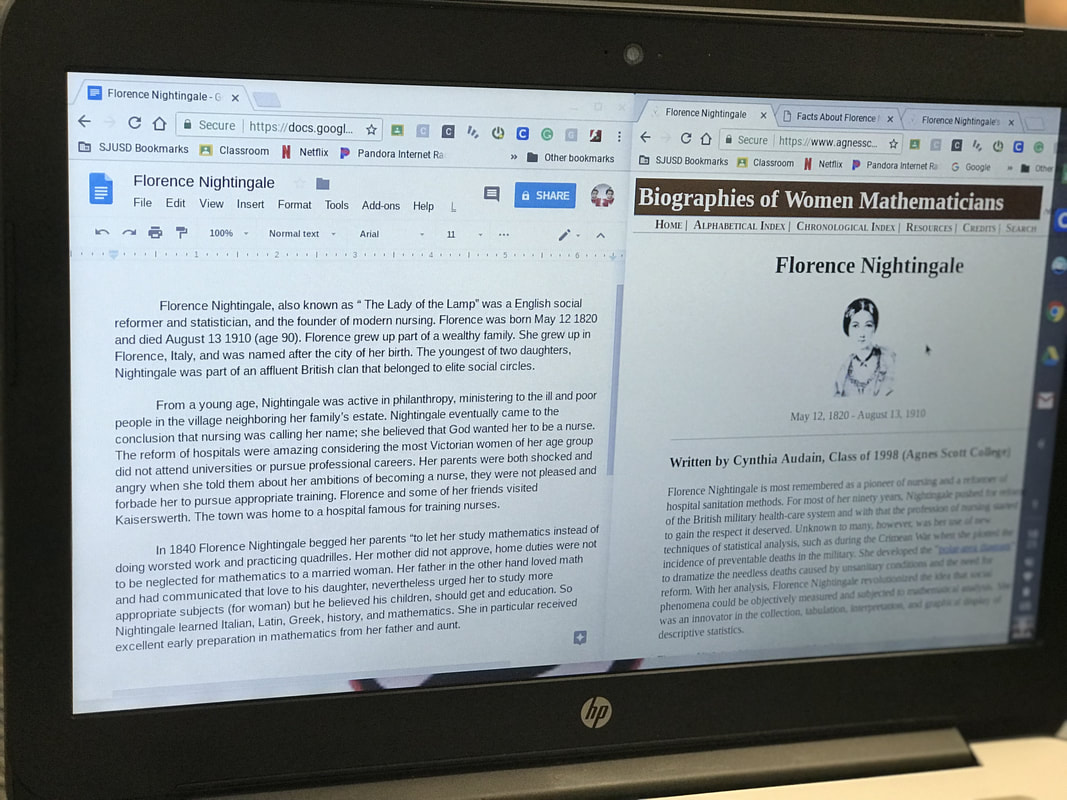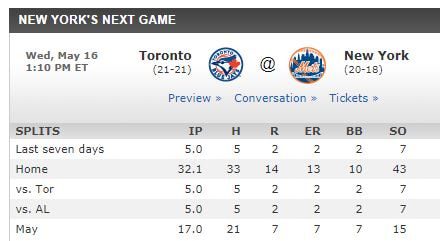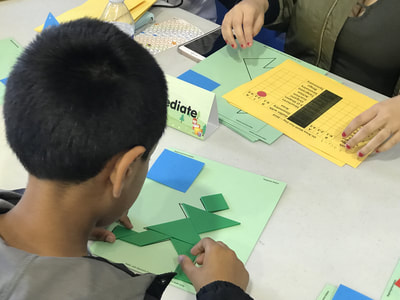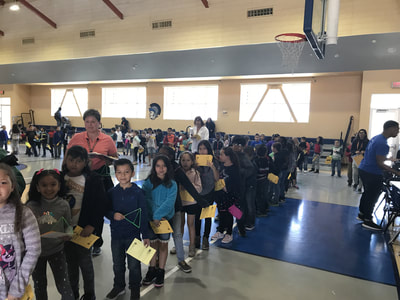|
Mariah Pettey Period 1 Dr. Smith Math project / Katherine Johnson In 1939 Virginia's state president, Dr. John W Davis, selected Katherine and two male African American students as the first black students to be offered the opportunity to attend the states flagship school at West Virginia University. Katherine stopped teaching and signed up for the math graduate program. When Katherine finished her first session of the math program she decided to leave and start a family with her husband. Katherine went back to teaching after having her three daughters Constance, Joylette, and Katherine Gobble. In 1952 Katherine found out about open positions for an all-black west area computing advisory at the National Advisory Committee for Aeronautics in the Langley laboratory, Katherine and her husband decided to move their family so Katharine could take the opportunity. Katherine began working for Langley in the summer of 1953. Dorothy Vaughan assigned Katherine a project in the flight division Katherine was just temporary until she became permanent. Katherine began the next four years of her career analyzing data from each flight test Katherine also helped with plane crashes caused by turbulence. Katherine’s husband died of cancer in December, 1956 as she was finishing up her work for determining turbulence effects on planes. Katherine johnson changed history in so many ways for woman not only African American women but women all over the world . Katherine taught us not only can men do certain jobs but women should be honored and treated the same way as men should . Katherine was honored with many awards for her work. The awards are the 1967 Lunar orbiter spacecraft and operations team member award , The National Technical Associations designation mathematician of the year . She has earned degrees from SUNY Farmingdale , Maryland’s capital college , Virginia’s old Dominion West Virginia University. In November 2015 Former President Barack Obama presented Johnson with the Presidential Medal of Freedom. Taraji P Henson also turned Katherine’s novel into a oscar nominated feature film and Taraji played Katherine in the film Hidden Figures . As you can see Katherine Johnson changed history not only for women but for African American men and Women and we honor her legacy and achievements. She truly has changed history for the world and showing us not only men can be mathematicians and get honored but women can also .
0 Comments
Too many students arrive at high school without the basic math fundamental skills. The rules of divisibility is one of the critical skills that is crucial to being able to understand conceptually division and fractions. Below is listed the rules of divisibility for the number 1-12. 1 Any integer (not a fraction) is divisible by 1 2 The last digit is even (0,2,4,6,8) 128 Yes 129 No 3 The sum of the digits is divisible by 3 381 (3+8+1=12, and 12÷3 = 4) Yes 217 (2+1+7=10, and 10÷3 = 3 1/3) No This rule can be repeated when needed: 99996 (9+9+9+9+6 = 42, then 4+2=6) Yes 4 The last 2 digits are divisible by 4 1312 is (12÷4=3) Yes 7019 is not (19÷4=4 3/4) No A quick check (useful for small numbers) is to halve the number twice and the result is still a whole number. 12/2 = 6, 6/2 = 3, 3 is a whole number. Yes 30/2 = 15, 15/2 = 7.5 which is not a whole number. No 5 The last digit is 0 or 5 175 Yes 809 No 6 Is even and is divisible by 3 (it passes both the 2 rule and 3 rule above) 114 (it is even, and 1+1+4=6 and 6÷3 = 2) Yes 308 (it is even, but 3+0+8=11 and 11÷3 = 3 2/3) No 7 Double the last digit and subtract it from a number made by the other digits. The result must be divisible by 7. (We can apply this rule to that answer again) 672 (Double 2 is 4, 67-4=63, and 63÷7=9) Yes 105 (Double 5 is 10, 10-10=0, and 0 is divisible by 7) Yes 905 (Double 5 is 10, 90-10=80, and 80÷7=11 3/7) No 8 The last three digits are divisible by 8 109816 (816÷8=102) Yes 216302 (302÷8=37 3/4) No A quick check is to halve three times and the result is still a whole number: 816/2 = 408, 408/2 = 204, 204/2 = 102 Yes 302/2 = 151, 151/2 = 75.5 No 9 The sum of the digits is divisible by 9 (Note: This rule can be repeated when needed) 1629 (1+6+2+9=18, and again, 1+8=9) Yes 2013 (2+0+1+3=6) No 10 The number ends in 0 220 Yes 221 No 11 Add and subtract digits in an alternating pattern (add digit, subtract next digit, add next digit, etc). Then check if that answer is divisible by 11. 1364 (+1−3+6−4 = 0) Yes 913 (+9−1+3 = 11) Yes 3729 (+3−7+2−9 = −11) Yes 987 (+9−8+7 = 8) No 12
The number is divisible by both 3 and 4 (it passes both the 3 rule and 4 rule above) 648 (By 3? 6+4+8=18 and 18÷3=6 Yes) (By 4? 48÷4=12 Yes) Both pass, so Yes 524 (By 3? 5+2+4=11, 11÷3= 3 2/3 No) (Don't need to check by 4) No After the SBAC testing Math students were engaged in writing about concepts and their favorite Mathematicians and math concepts. The task requires research, drafting a five paragraph essay using the Jane Schaffer framework, and preparing a presentation using Power Point or other software. Student use their close reading and annotation skills to help prepare their writing strategies. Student's have come a long way and the project brings about interesting conversation with students learning math using engaging activities. This year math has been fun and engaging for all students in the California Model Continuation High School. We are Math Warriors.
Batter CalculationsStep 1 -Calculate Herrera's Batting Average and Slugging Percentage Below is the career batting statistics for Bryce Harper PITCHER CALCULATIONSCalculate his Earned Run Average (ERA) and his Walks plus Hits Innings Pitched Percentage (WHIP)
Calculate your Favorite players statistics and make a slide presentation of the calculations. Pay
The median annual wage for mathematicians was $101,360 in May 2012. The median wage is the wage at which half the workers in an occupation earned more than that amount and half earned less. The lowest 10 percent earned less than $56,040, and the top 10 percent earned more than $152,950. In May 2012, the median annual wages for mathematicians in the top five industries in which these mathematicians worked were as follows: Scientific research and development services$118,030 Manufacturing116,860 Federal government106,360 Management of companies and enterprises74,980 Educational services; state, local, and private66,590Most mathematicians work full time. Deadlines and last-minute requests for data or analysis may require overtime. In addition, mathematicians may have to travel to attend seminars and conferences. Job OutlookEmployment of mathematicians is projected to grow 23 percent from 2012 to 2022, much faster than the average for all occupations. However, because it is a small occupation, the fast growth will result in only about 800 new jobs over the 10-year period. The amount of digitally stored data will increase over the next decade as more people and companies conduct business online and use social media, smartphones, and other mobile devices. As a result, businesses will increasingly need mathematicians to analyze the large amount of information and data collected. Analyses will help companies improve their business processes, design and develop new products, and even advertise products to potential customers. Mathematicians will also be needed to help information security analysts create data-security systems to protect the confidentiality and personal information of individuals. Second and Third graders from De Anza Elementary school participate in fun math activities with Mountain View High School from 9 AM-12 PM, March 27, 2018.
The formula for Success: Engaging Families in Early Math Learning Early math ability is one of the best predictors of children’s later success in school because children’s learning begins in the home, families are fundamental in shaping children’s interest and skills in math. The experience of learning and doing the math, however, looks different from the instruction that previously taught when most adults were in school, and many parents harbor anxiety about math. For this reason, families need guidance, inspiration, and motivation to support their young children’s mathematical development efficiently. Research shows that math is part of our everyday lives, and as such, is conditioned by relationships, culture, and values; math can be an enjoyable parent-child experience; and Young children’s math development begins in infancy and continues throughout the early childhood years and beyond. Moreover, children learn math anytime, anywhere, even before they go to preschool. For this reason, families are critical to supporting children’s mathematics development. They can provide this support directly by using objects for counting, stacking, and recognizing shapes. They can also offer assistance indirectly, by connecting their children to math learning environments outside of the home (e.g., in libraries, museums, early childhood programs). However, to do so, families need access to information about what math development is and how to support it, which is often not transparent or readily available. What do young children need to know about math? Families and educators recognize that number concepts are essential for children’s math development. However, geometry and measurement also represent fundamental ideas young children benefit from learning about in their homes and community settings. |
Dr. Smith
|
- Home
- CAASPP/SBAC PREP
- Orientation
- Dr. Smith MATH BLOG-2017-2018
- Privacy Policy
- Hour of Code
- Math Fun Night Videos
- CCHS MATH I
- CCHS MATH II
- CCHS MATH III
- Art of Math
- Parents
- RTI-FLOWMAP
- WOF-Good
- Hourofcode
- Content Objectives
- Common Core Standards
- Geometry Proofs
- MusicBlog
- CCHS Kahoot Challenge
- MATH & PEOPLE
- JavaScript Programming
- Star Wars
- Pearson Video Help
- Conference Presentations
- SBAC Practice #1
- SJAE Exit Survey
- CCEA MATH Resources
- CCHS MATH BLOG-2018-2019
- Brain-Based Research
- Stock Market Game


































 RSS Feed
RSS Feed
